Sesbania Grandiflora / Vegetable humming bird / Agati / বকফুল।

General features: The botanical name is Sesbania grandiflora (S grandiflora) but commonly called ‘Vegetable hummingbird’ or ‘Agati’ in English. In India, particularly in Bengal the colloquial name is Bok-phul (বকফুল). The plant belongs to the genus of Sesbania and family of Fabaceae. It is a fast-growing plant reaching to 20 – 30 ft high and composed of soft woods. The leaves are 8 -12 inches long grown as leaflets of 10 – 20 pairs. The flowers are oblong 2- 4 inches in length in lax with 2 – 4 flower racemes. They are mostly white but occasionally red, pink and yellow varieties are also available. The pods are slender and straight. They are 12 – 18 inches long holding ~ 30 seeds inside which are 0.3 inch in the sizes. The plant is believed to be the native of South East Asian nations or Northern Australia. The tree has been cultivated in several regions of India including also Sri Lanka requiring largely hot, sunny and humid climate. The flowers of S grandiflora are consumed as vegetable in many South Asian and South East Asian nations eg, Vietnam, Laos, Thailand, Philippine, Java, Sri Lanka, India and Maldives. They are mainly used in making the curries. But besides making curries, the young pods and leaves are also used in the salads. In Bengal, the flowers are eaten by frying in dipping with lentil batter. In Sri Lanka and other Southern Indian states like in Tamilnadu, fresh green pods and leaves are consumed to make curry using coconut gravy. Recently, it is noted that leaf extract enables to inhibit the formation of advanced glycation end-products which presumably is the cause behind several neurological disorders like Alzheimer. The large reserve of linoleic and aspartic acid is thought to be liable for the anti-glycation action.
Mythological viewpoints: It has been described by the Hindu mythology that flower of S grandiflora was appreciated during ancient Vedic period of India by many sages (munis) including the famous personality like Agastya, a great sage and scholar who seems to be the author of many books like Skanda Purana, Varah Purana, Agastya Samhita and several others. According to the legend, he was the pioneer in constructing medicinal aspects of numerous plants in order to treat various ailments inscribed in Atharva Veda, the ancient Indian Medica. His wife, Lopamudra was one of the great philosophers of ancient India. It is also a folk lore that the flowers of Sesbania grandiflora are born at the shining of star, Agastya seen pointing to the north of Sirius. Further the legend says that following the advice of King of the heaven (Devraj) God Indra, Agastya started the practice of medicine using the herbs from the herbal enriched Himalayan region, viewing as the major source. Presumably, the name ‘Agati’ is offered to S grandiflora plant following the Nepali language since Nepal is the country situated on the Himalaya. The countless medicinal virtues of this plant particularly leaves and flowers or even the bark and roots were revealed by the great sage to cure numerous illnesses.
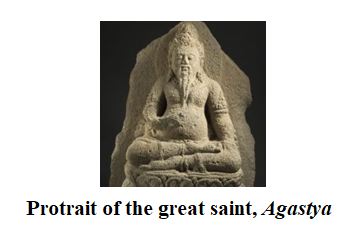
Edible uses: Flowers – They are used either as cooked or raw condition in salads. But it is mostly preferred to make curries or deep fried after dipping in the batter. It is a delicacy in many places of India. The center of the flowers is removed before any use. The flowers of S grandiflora are enriched with sugar and minerals particularly iron. It produces a flavor of mushrooms. The fresh young pods are cooked as vegetable like stews or else used in the salads. The seeds isolated from matured pods are cooked as lentils which are full of proteins. In some Asian nations, the pods are fermented to produce syrup often used in cooking foods.
Folk medicinal uses: In rural India, the young leaves are used for diuretic and aperient actions. The crushed leaves are also used as a poultice for curing sprains, bruises and swellings. It is also applied for rheumatism and itches. Tea prepared from the dried leaves has antibiotic, antitumor and contraceptive properties. The bark extract has astringent taste but exhibits several beneficial effects acting as febrifuge, tonic, anti-pyretic, preventing diarrhea, dysentery, colic or any gastric troubles. In several places of India it is even used in controlling the diabetes. The flower extract is used as emollient, laxative, preventing sinus congestion. In many regions pastes made of young roots are applied to treat rheumatism. It is believed that consumption of flowers can prevent night blindness whereas the juice from fruits would improve the memory. The leaf extract is believed to exert anxiolytic effect.
Phyto-chemicals and actions: Each part of the plant is a rich source of minerals, vitamins and several other beneficial factors.
Leaf – Per 100 g – 8.4 g protein, 1.4 g fat, 2.2 fiber, 1700 mg Ca, 260 mg P, 4.0 mg Fe, 9000 IU vitamin A, 0.21 mg Thiamine, 0.1 g Riboflavin, 9.2 mg Niacin, 270 mg vitamin C, 2005 mg K, 2600 µg β – carotene.
Flower – Per 100 g – 14.5 g protein, 4.0 g fat, 77.3 g carbohydrate, 10.9 g fiber, 145 mg Ca, 300 mg P, 5.5 mg Fe, 291 mg Na, 1400 mg K, 640 µg β – carotene, 1.0 g Thiamine, 0.72 mg Riboflavin, 14.5 mg Niacin, 473 mg vitamin C.
Seed oil – 12.3 % palmitic, 5.2 % stearic, 26.2 % oleic and 53.4 % linoleic acids.
Bioactive components – The major bioactive chemicals identified in the methanolic extract of leaves are: alkaloids, glycosides, steroids, terpenoids and tannins. In addition, there are others like 3, 4, 5-trimethoxy-phenol, erucic acid, 2-furancarboxyladehyde, vitamin E, 4 – methyl-oxazole, palmitic acid, 9 – hexa-decanol and di-octyl esters. The existence of alkaloids have been traced but none have been isolated nor are any structures established. The alcoholic extract of leaves also have high level of Quercitin, Myricetin, and Kaempferol. The other major compounds isolated and identified in roots are the iso-flavonoids like, Isovestitol, Medicarpin, Sativan and the other lupane type triterpene, Betulinic acid.
Besides other organic components belonging to the family of terpenes and flavonoids, a novel protein, SF2 has been isolated from the S grandiflora flower which shows potent anticancer / antitumor actions in course of in vivo and in vitro experimentation by preventing cell proliferation while inducing apoptosis demonstrated by the DNA fragmentation and externalization of phosphatidyl serine in cell lines like colon cancer SW480 or Dalton lymphoma ascites. Presumably, the activation of Caspase 3, 8 and 9, poly ADP – ribose polymerase cleavage along with Cytochrome C release indicates apoptosis inducing cell death. The mechanism involved is the down regulation of apoptotic factors like Bcl-2, p-Akt, COX-2 etc. Advantageously, the protein does not exhibit any toxicity. The protein also shows analgesic and anti-inflammatory actions possibly due to the inhibition of COX-2 generation. Further, the presence of Isovestitol, Medicarpin and Sativan displayed considerable anti-tubercular and antimicrobial property.
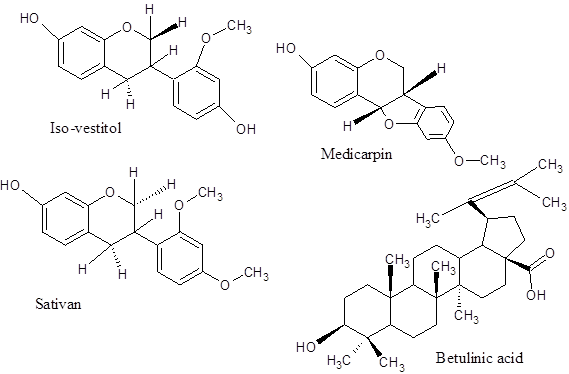
Essentially, various tannins, flavonoids steroids and coumarins are identified in all parts of the plant. The majority in the form of saponins are either triterpenes or steroidal by the nature. The very commonly found ingredients are Leucocyanidin and Cyanidines which in largely available within the seeds whereas the flowers majorly synthesize Oleanolic acid or its methyl ester and Kaempferol – 3 – rutenoside. The bark produces large quantities of gum and tannins.
Erucic acid – CH3 (CH2)7 CH = CH (CH2)11 CO2H. It is a mono-unsaturated ω – 9 fatty acid. It exists in most of the edible oils (canola, mustard, sunflower, corn etc) in appreciable amounts. It is synthesized by the enzymatic elongation of Oleic acid. It breaks down to shorter fatty acids inside the human liver. Experiments in rats showed that its consumption causes myocardial lipidosis within animals but no such occurrences are ever noticed in the case of human.
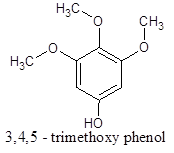
3, 4, 5 – tri-methoxy phenol –
The compound, 3, 4, 5-trimethoxy phenol inhibits Tyrosyl-DNA-phosphodiesterase-1 (Tdp1) also takes part in the synthesis of Co-enzymes Q. It is a potential anticancer drug thus widely employed as chemotherapeutic agent. The enzyme, Tdp1 catalyzes the hydrolysis of DNA adducts when covalently linked to the 3` – phosphate of DNA. The inhibitors of Tdp1 targets not only the Topoisomerase -1 but also synergizes with various other commercially available drugs including the inhibitors of Topoisomerase – 2 and other DNA alkylating agents also.
2 – Furancarboxyladehyde / Furfural –

The compound shows anti-malarial effect. It also acts as antagonists to peroxisome proliferators but agonist toward Estrogen β – receptor pathway.
4- methyl-oxazole –

The compound exhibits numerous physiological role by acting as bronchodilator, anti-asthmatic, kidney and prostate problems. Various oxazole derivatives are widely known for their physiologic role in medicines.
Medicarpin –
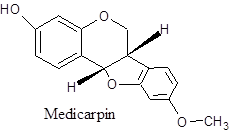
Medicarpin stimulates osteoblasts for bone generations also heals several bone defects. Further, it exhibits anti-fungal and anti-parasite activities also enables to prevent cancer cell proliferations.
Betulinic acid –
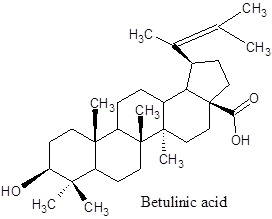
It is a pentacyclic tri-terpenoid. The compound shows anti-retroviral, anti-inflammatory and anti-malarial properties. Uniquely it exhibits anti-cancer / anti-proliferative effect while inhibiting the enzyme Topoisomerase also activating Caspases, subsequently inducing apoptosis of tumor cells, as evidenced by the fragmentation of DNA.
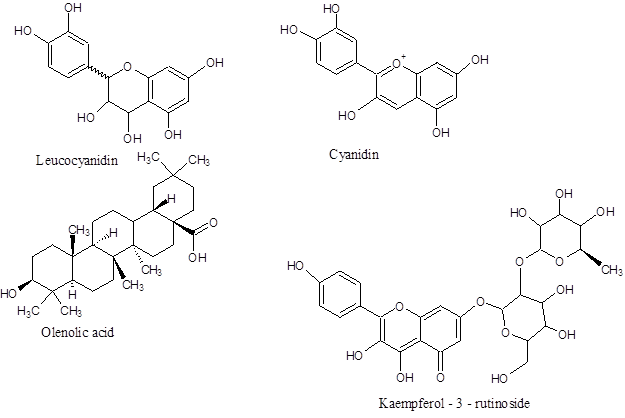
Oleanolic acid –
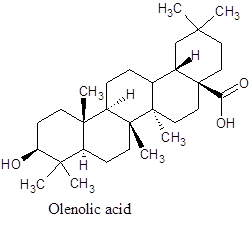
It is a pentacyclic triterpene. It exhibits anti-tumor, antiviral, hepato-protective properties. Recent studies indicate that Oleanolic acid can act as anti-HIV and anti-HCV drug. Some of its derivatives work more potently in that regard. It is a powerful anti-inflammatory compound works by inducing Interferon – γ. It also reduces sperm motility as well as the quality thereby causing temporary infertility to the men. Withdrawing it helps regaining the fertility back to the original state.
Flavonoids –
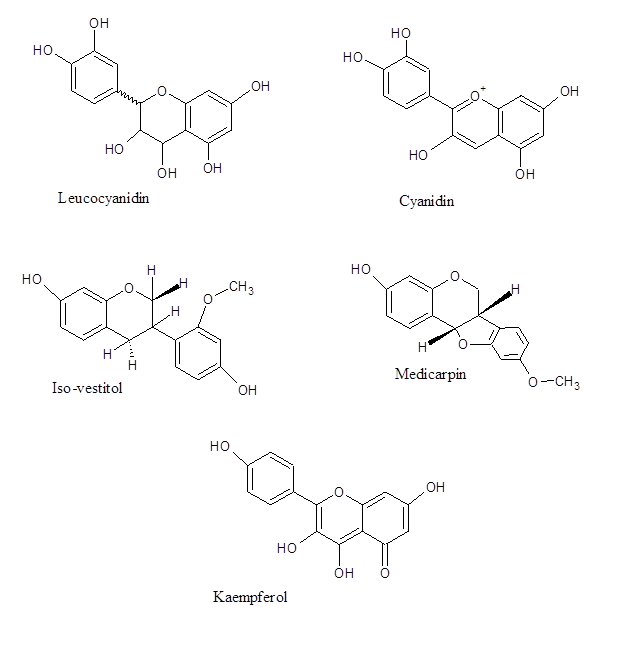
Those are the major flavonoids identified either in free or coupled with the glycosides within different parts of S grandiflora plant. Factually, it has been firmly established that flavonoids are immensely beneficial for maintain good health. They are powerful anti-oxidants. The action mostly relies on its final break down to Uric acid which actually plays the major antioxidant role. Besides this act, these flavonoids inhibit blood coagulation, thrombus formation including the aggregation of platelets thereby reducing the risk of atherosclerosis. They intend to reduce the oxidative stress also its related signaling pathways. As per further benefits, they improve capillary functions, regulate vascular inflammatory mechanisms causing reduction of arterial blood pressure lowering the risk of hypertensions and hyperglycemia including the process of aging.
Pharmacological actions:
Hypoglycemic effect – The antidiabetic effect of flower extract has been confirmed by laboratory experiments using Streptozotocin, Alloxan induced or glucose overloaded animals. The results showed that oral administration of fruit and flower extract restored all the parameters eg, plasma glucose, serum insulin glycosylated hemoglobin, hepatic glycogen, serum marker enzymes aspartate and alanine transaminase, creatinine sulfate, glycogen and alkaline phosphatase and others. It also lowers triglyceride, cholesterol and LDL and considerably enhances superoxide dismutase and catalase action indicating the lowering of lipid peroxidation.
Hypourecimia effect – Uricemia induced by the high fructose diet is a metabolic syndrome causes an increased level of uric acid in the circulation. The reduction of uric acid is an innovative treatment to control the diabetes also. The aqueous extract of S grandiflora leaves can bring the levels of uric acid and Creatinine down to the normal.
Inhibitory actions toward enzymes – The fruit and flower extracts of S grandiflora can lower Advanced Glycation End (AGE) products as well as the early glycation of hemoglobin (HbA1c). The inhibition of enzymes like α – amylase and α- glucosidase by the extracts which is responsible for the carbohydrate metabolism could be responsible for that actions. The alcoholic extracts show significant reduction of α – amylase (52 %) and α- glucosidase (56 %) activities. Considerable reduction (~ 50 %) of glycation to form HbA1c is also noticed when using the alcoholic extract of flowers. Although the presence of Piperidine, Cinnamaldehyde and Linoleic acid are identified as being the liable factors but the recent isolation of two proteins SGF60 and SGF90 are also seen to be the additional cause behind these effects.
Anti-inflammatory effect – The large reserve of flavonoids along with several triterpenes are the source of strong anti-inflammatory actions. It has been known that procyanidins and flavonoids enable to trap chemically the generated reactive oxygen and inducible nitric oxide. Flavonoids can also inhibit the enzymes liable for producing those reactive free radical species. The enzymes are COX, LOX and iNOS. By inhibiting them they prevent to generate the inflammatory mediators.
Anti-cancer effect – The alcoholic or other solvent extracts of S grandiflora leaf exerts significant anti-proliferative and apoptotic effects on various human cancer cell lines like breast (MCF-7), Liver (Hep-G2 & Hep-2), lung (A549) and colon (HT-29 & HCT-116) including neuroblastoma (IMR-32). Activation of caspase, decrease in mitochondrial membrane potential, reduction in the activation of NF-κβ were observed in all cases indicating the presence of effective constituent(s) within the leaf. The methanolic extract is particularly more effective toward the lung cancer cells, A549.
Miscellaneous effects –
- Cardiovascular effects – lowering of cholesterol, LDL, VLDL and triglycerides by the leaf extract.
- Anti-microbial effect – Highly potent against Bacillus cereus, Micrococcus luteus, Staphylococcus epidermidis, Clostridium sporogens, Streptococcus faecalis, Streptococcus pyogens, Staphylococcus aureus, Bacillus subtilis, Agrobacterium tumifaciens, Klebsiella pneumoniae, Salmonella typhi, Pseudomonas aeruginosa, Serratia marcesens, Entobacteria aerogens, Proteus vulgaris and Escherichia coli). The petroleum ether and alcoholic extracts exhibited mild antifungal property against the tested fungal strains like Cryptococcus neoformans, Gibberella fugikoroi, Rhizophus oligosporus, Neurospora classa, Myrothecium verrucasia, Aspergillus Niger and Candida albicans.
- Anti-arthritic action – The effect is due to its potent anti-inflammatory actions.
- Leucorrhea – The flower extract is used in treating leucorrhea for women caused by the imbalance of estrogen.
- Anti-asthmatic effect – The bark extract shows broncho-dilatory and antiasthmatic effects.
- Effect on memory – The ethanolic extracts of S grandiflora seeds show significant neuroprotective role among the laboratory mice experiments. The extract reestablished memory in case of drug (Celecoxib) induced amnesia within the animals. Further it reduces the action of Acetylcholine esterase and restore the antioxidant enzymes like SOD, GSH and Catalase in the experimental animals. The extract helps improve cognitive dysfunction in drug treated animals while modifying the cholinergic system. In that way, it is a good preventive substance in developing Alzheimer’s disease by blocking any oxidative stress. Also inhibition of advanced glycated end product (AGE) formation is an additional aspect in this regard because presumably those are one of the constituents in Alzheimer plaques of brain.